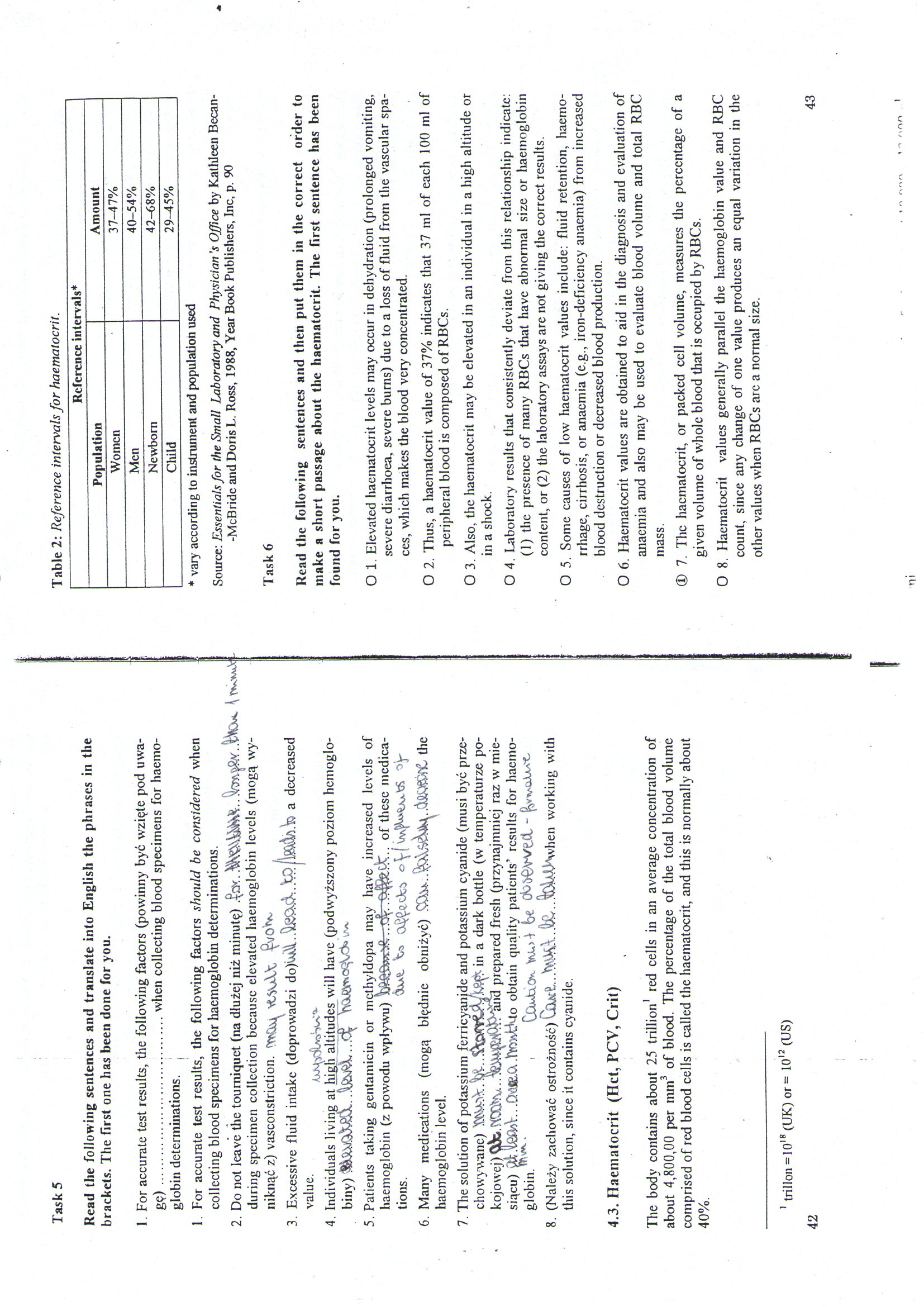img501

Task 5
Read the following sentences and translate into English the phrases in the brackets. Tłie First one has been done for you.
1. For accurate test results, the following factors (powinny być wzięte pod uwagę) ..................................when collecting blood specimens for haemo-
globin detenninations. ,
1. For accurate test results, the following factors should be considered when collecting blood specimens for haemoglobin detenninations.
2. Do not leavc tiie toumiquet (na dłużej niż minutę) \
during spccimen collcction becausc elevated haemoglobin levels (mogą wyniknąć z) vasconstriction. Wiijy
3. Excessive fluid intakc (doprowadzi do)VA*^..^&&.X£la dccreased Va,Ue'
4. lndividuals 1 iving at high altitudes will have (podwyższony poziom hemoglobiny) tolM..
5. Patients taking gentamicin or mcthyldopa may have incrcascd lcvcls of
haemoglobin (z powodu wpływu) rr£^:~.. of thesc mcdica-
tions. |
6. Many inedications (mogą błędnie obniżyć) the
haemoglobin level.
7. Tlie solution of potassium ferrieyanide and potassiuin cyanide (musi być przechowywane) in a dark bottle (w temperaturze pokojowej) prepared fresh (przynajmniej raz w miesiącu) ytt.iSfloY.. .tYO)vfcW> oblain quality patients’ results for haemoglobin. , CcuJaCK W*>4 b* (^v>GVVt£t - ^vvoXaa*c
8. (Należy zachować ostrożność) ..^A^kKvhen working with tliis solution, sińce it contains cyanide.
4,3. Haematocrit (Het, PCV, Crit)
The body contains about 25 trillion1 red cells in an average concentration of about 4,800,00 per mm3 of blood. The percentage of the total blood voIume comprised of red blood cells is called the haematocrit, and tliis is normally about 40%.
Table 2: Reference interrals for haematocrit.
|
Rcfcrcnce intcrvals* | |
|
Population |
Amount |
|
Woincn |
37-47% |
|
Men |
40-54% |
|
Newborn |
42-68% |
|
Cliild |
29-45% |
* vary according to instrument and popułalion used
Source: Essentials for the Smali Laboratory and Physician 's Office by Kathleen Becan--McBridc and Doris L. Ross, 1988, Year Book Publishers, Inc, p. 90
Task 6
Read the following sentences and then put tlieni in the correct order to
make a short passage about the haematocrit. The first sentence has been
found for you.
O 1. Elevated haematocrit levels may occur in dchydration (prolonged vomiting, severe diarrhoea, severe burns) due to a loss of fluid from the vascu!ar spa-ces, which makes tire blood very' concenlrated.
O 2. Thus, a haematocrit value of 37% indicates that 37 ml of each 100 ml of peripheral blood is composed of RBCs.
O 3. Also, tire haematocrit may be elevated in an individual in a high altitude or in a shock.
O 4. Laboratory results that consistcntly deviate from tliis relationship indicate: (1) the presence of many RBCs that have abnormal size or haemoglobin content, or (2) the laboratory assays are not giving the correct results.
O 5. Sonie causes of Iow haematocrit valucs include: fluid retention, haemo-rrhage, cirrhosis, or anacmia (e g., iron-deficicncy anaemia) from increased blood destruction or decreased blood production.
O 6. Haematocrit values are obtained to aid in the diagnosis and evaluation of anaemia and also may be used to evaluatc blood volume and total RBC mass.
(D 7. Tlić haematocrit, or packcd ccii vo!ume, measures the percentage of a given volume of whole blood that is occupied by RBCs.
O 8. Haematocrit values generally parallel the haemoglobin value and RBC count, sińce any change of one value produces an equal variation in tlie other values when RBCs are a normal size.
-> f\r\r\
43
trillon =1018 (UK) or = 1012 (US)
Wyszukiwarka
Podobne podstrony:
DSCN0911 TA-SK 5: Translate the following words and expressions into English i
TASK 5. (0-4) Read the article. Four sentences have been removed from the text. Complete each gap (5
9 Tanzimat and “Mecelle” 115 published. In the following years further translations into variou
ANG2 k2 05 3 III. Stock Exchange terms. A) Complete the following sentences and answer the following
Irregular verbs 3. Good luck © Name Score ..A. % .i.*?..... Mark .. !l. h Translate into English the
Irregular verbs 4. Good luck © Name . Score* 41 *5 Mark c Translate into English the following irreg
interactive naturę of the learning process; the ku4hańga or bat-tamiz initiate (which translate into
img015 being translated into English. However, a video of the exercises was released in English in 1
jff 119 GLOSSARY The use of Japanese terms has been kept to a minimum in this book. It is an imposit
m1360 S. Romano (1432) The Rout of San Romano has been immortalised by Uccello’s famous paintings, b
Pn 12:11 o Q O O O Qg? GATUNKI^ English Literaturę Epic poetry, Greek --Translations into Engli
earthquakes have been analyzed (69]; the disperslon of such waves has been used to determłne models&
18707 kotek 2 REFLF CTION (78w x 118h) Work whiskers and eyebrows in long, loose stitches after desi
więcej podobnych podstron